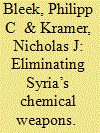|
|
|
Sort Order |
|
|
|
Items / Page
|
|
|
|
|
|
|
| Srl | Item |
| 1 |
ID:
172053


|
|
|
|
|
| Summary/Abstract |
Terrorists combining motivations and capabilities to conduct significant chemical, biological, radiological, or nuclear (CBRN) attacks are, logically and empirically, outliers. Certain characteristics of radical environmentalism heighten the risk of such outliers. The majority of even radical environmentalists embrace nonviolence. Those who turn violent mostly do so in limited ways due to a combination of motivations and capabilities. Fringe elements are motivated to commit large-scale—including CBRN—violence, but are mostly constrained by capability. Yet eco-radicalism also draws more capable adherents. If serious CBRN terrorism attacks occur—a risk about which analysts differ markedly—radical environmentalist fringe actors are plausible perpetrators.
|
|
|
|
|
|
|
|
|
|
|
|
|
|
|
|
| 2 |
ID:
147685


|
|
|
|
|
| Summary/Abstract |
The 2013–14 disarmament of Syria's chemical-weapons capabilities was a rare bright spot in a brutal civil war with no end in sight. The remarkable US-led, international effort to bring Damascus into the 1997 Chemical Weapons Convention, inventory its capabilities, and then verifiably destroy them is a fascinating and, to date, largely untold story. A substantial US government interagency effort centered in the Defense Department laid the diplomatic, technical, and procedural foundations for Syria's disarmament in the year prior to the August 2013 chemical-weapons attack in Ghouta that galvanized Syria's subsequent disarmament. An intrinsically interesting case, Syria's chemical-weapons disarmament has important implications for possible future WMD elimination operations elsewhere.
|
|
|
|
|
|
|
|
|
|
|
|
|
|
|
|
| 3 |
ID:
131238


|
|
|
|
|
| Publication |
2014.
|
| Summary/Abstract |
As Iran continues its apparent pursuit of a nuclear weapons breakout capability and North Korea resists efforts to roll back its proliferation, policy makers in Washington eager to prevent further proliferation in both regions regard security guarantees to allies as crucial tools. But recent scholarship calls into question whether security guarantees ameliorate proliferation risks. Relying on a combination of large-N quantitative analysis and a case study of South Korea from the late 1960s to the mid-1980s, this article argues that, consistent with policy makers' conventional wisdom, security guarantees significantly reduce proliferation proclivity among their recipients.
|
|
|
|
|
|
|
|
|
|
|
|
|
|
|
|
| 4 |
ID:
167798


|
|
|
|
|
| Summary/Abstract |
Drone swarms—multiple unmanned systems capable of coordinating their actions to accomplish shared objectives—have major implications for the future of warfare. One important set of implications relates to the ability of drone swarms to complement, challenge, and even substitute for chemical, biological, radiological, and nuclear (CBRN) weapons. For example, swarming drones might enable more effective CBRN delivery. Or they might facilitate standoff detection, search the oceans for nuclear-armed submarines, or otherwise impede an adversary’s ability to threaten or employ CBRN weapons. Conventionally armed drone swarms might serve as strategic deterrents in lieu of CBRN weapons. At the same time, many CBRN-relevant applications of drone-swarm technology entail significant technical challenges even for very sophisticated states, and even more so for non-state actors whose capabilities will be far more limited, so there is considerable uncertainty around whether, how much, and when drone-swarm technology will complement, challenge, or substitute for CBRN weapons.
|
|
|
|
|
|
|
|
|
|
|
|
|
|
|
|
| 5 |
ID:
114964


|
|
|
|
|
| Publication |
2012.
|
| Summary/Abstract |
As Iran steadily develops the capacity to construct nuclear weapons, Washington and Ankara are increasingly on the same page, although key differences persist. Since the start of the Arab uprisings, Turkey and Iran have found themselves supporting different political factions in Syria and Bahrain. Turkey has retreated from its self-assigned role as Iran's diplomatic defender following a period of unusual warmth between Ankara and Tehran in 2009 and 2010. The current regional dynamics have pushed Ankara's immediate foreign-policy interests back into broad alignment with those of its traditional Western allies, notably Washington.
|
|
|
|
|
|
|
|
|
|
|
|
|
|
|
|
|
|
|
|
|